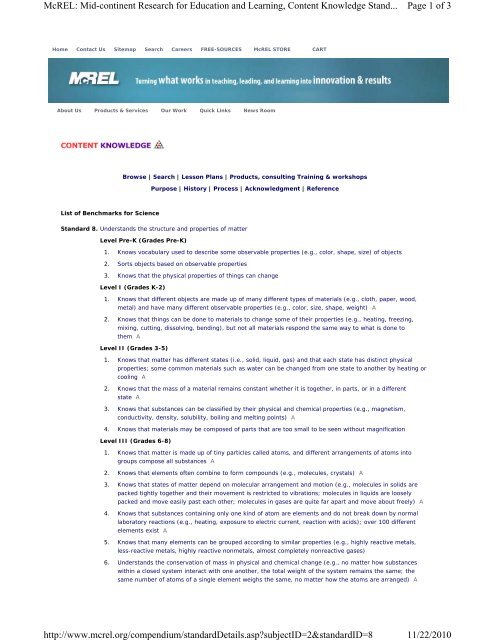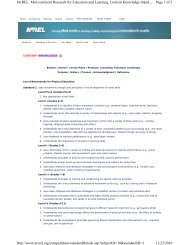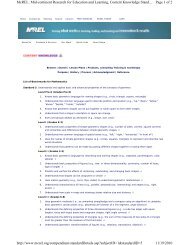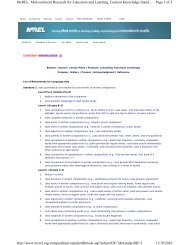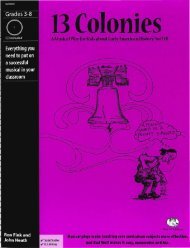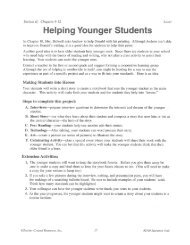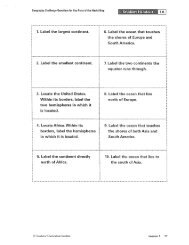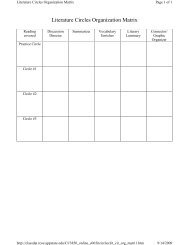McREL Standard 08 Physical
McREL Standard 08 Physical
McREL Standard 08 Physical
- No tags were found...
You also want an ePaper? Increase the reach of your titles
YUMPU automatically turns print PDFs into web optimized ePapers that Google loves.
<strong>McREL</strong>: Mid-continent Research for Education and Learning, Content Knowledge Stand...http://www.mcrel.org/compendium/standardDetails.asp?subjectID=2&standardID=8Page 1 of 311/22/2010Home Contact Us Sitemap Search Careers FREE-SOURCES <strong>McREL</strong> STORE CARTAbout Us Products & Services Our Work Quick Links News RoomBrowse | Search | Lesson Plans | Products, consulting Training & workshopsPurpose | History | Process | Acknowledgment | ReferenceList of Benchmarks for Science<strong>Standard</strong> 8. Understands the structure and properties of matterLevel Pre-K (Grades Pre-K)1. Knows vocabulary used to describe some observable properties (e.g., color, shape, size) of objects2. Sorts objects based on observable properties3. Knows that the physical properties of things can changeLevel I (Grades K-2)1. Knows that different objects are made up of many different types of materials (e.g., cloth, paper, wood,metal) and have many different observable properties (e.g., color, size, shape, weight) A2. Knows that things can be done to materials to change some of their properties (e.g., heating, freezing,mixing, cutting, dissolving, bending), but not all materials respond the same way to what is done tothem ALevel II (Grades 3-5)1. Knows that matter has different states (i.e., solid, liquid, gas) and that each state has distinct physicalproperties; some common materials such as water can be changed from one state to another by heating orcooling A2. Knows that the mass of a material remains constant whether it is together, in parts, or in a differentstate A3. Knows that substances can be classified by their physical and chemical properties (e.g., magnetism,conductivity, density, solubility, boiling and melting points) A4. Knows that materials may be composed of parts that are too small to be seen without magnificationLevel III (Grades 6-8)1. Knows that matter is made up of tiny particles called atoms, and different arrangements of atoms intogroups compose all substances A2. Knows that elements often combine to form compounds (e.g., molecules, crystals) A3. Knows that states of matter depend on molecular arrangement and motion (e.g., molecules in solids arepacked tightly together and their movement is restricted to vibrations; molecules in liquids are looselypacked and move easily past each other; molecules in gases are quite far apart and move about freely) A4. Knows that substances containing only one kind of atom are elements and do not break down by normallaboratory reactions (e.g., heating, exposure to electric current, reaction with acids); over 100 differentelements exist A5. Knows that many elements can be grouped according to similar properties (e.g., highly reactive metals,less-reactive metals, highly reactive nonmetals, almost completely nonreactive gases)6. Understands the conservation of mass in physical and chemical change (e.g., no matter how substanceswithin a closed system interact with one another, the total weight of the system remains the same; thesame number of atoms of a single element weighs the same, no matter how the atoms are arranged) A
<strong>McREL</strong>: Mid-continent Research for Education and Learning, Content Knowledge Stand...http://www.mcrel.org/compendium/standardDetails.asp?subjectID=2&standardID=8Page 2 of 311/22/20107. Knows methods used to separate mixtures into their component parts (boiling, filtering, chromatography,screening) A8. Knows that substances react chemically in characteristic ways with other substances to form newsubstances (compounds) with different characteristic properties A9. Knows factors that influence reaction rates (e.g., types of substances involved, temperature, concentrationof reactant molecules, amount of contact between reactant molecules) A10. Knows that oxidation is the loss of electrons, and commonly involves the combining of oxygen with anothersubstance (e.g., the processes of burning and rusting) ALevel IV (Grades 9-12)1. Knows the structure of an atom (e.g., negative electrons occupy most of the space in the atom; neutronsand positive protons make up the nucleus of the atom; protons and neutrons are almost two thousandtimes heavier than an electron; the electric force between the nucleus and electrons holds the atomtogether) A2. Understands how elements are arranged in the periodic table, and how this arrangement shows repeatingpatterns among elements with similar properties (e.g., numbers of protons, neutrons, and electrons;relation between atomic number and atomic mass)3. Knows how the electron configuration of atoms governs the chemical properties of an element as atomsinteract with one another by transferring or sharing the outermost electrons4. Knows that atoms may be bonded together into molecules or crystalline solids, and compounds are formedfrom chemical bonds between two or more different kinds of atoms A5. Knows that the physical properties of a compound are determined by its molecular structure (e.g.,constituent atoms, distances and angles between them) and the interactions among these molecules6. Knows that the number of electrons in an atom determines whether the atom is electrically neutral or anion (i.e., electrically neutral atoms contain equal numbers of protons and electrons; a positively chargedatom has lost one or more electrons; a negatively charged atom has gained one or more electrons) A7. Knows that most elements have two or more isotopes (i.e., atoms that differ in the number of neutrons inthe nucleus); although the number of neutrons has little effect on how the atom interacts with others, itdoes affect the mass and stability of the nucleus8. Knows how radioactive isotopes can be used to estimate the age of materials that contain them becauseradioactive isotopes undergo spontaneous nuclear reactions and emit particles and/or wavelike radiation;the decay of any one nucleus cannot be predicted, but a large group of identical nuclei decay at apredictable rate, which can be used to estimate the material’s age A9. Knows that neutrons and protons are made up of even smaller constituents10. Understands that chemical reactions either release or consume energy (i.e., some changes of atomic ormolecular configuration require an input of energy; others release energy) A11. Knows that chemical reactions can take place at vastly different rates (e.g., from the few femtosecondsrequired for an atom to move a fraction of a chemical bond distance to geologic times scales of billions ofyears) and reaction rates depend on a variety of factors that influence the frequency of collision of reactantmolecules (e.g., shape and surface area of the reacting species, temperature, pressure, the presence orabsence of a catalyst)12. Knows that chemical reactions can be accelerated by catalysts (e.g., metallic surfaces, enzymes)13. Understands the complete mole concept and ways in which it can be used (e.g., actual mass vs. relativemass; relationship between the mole and the volume of a mole of molecules; relevance of molar volumeand Avogadro’s hypothesis) A14. Knows the variety of structures that may be formed from the bonding of carbon atoms (e.g., syntheticpolymers, oils, the large molecules essential to life) and their roles in various chemical reactions, includingthose required for life processes15. Knows that a large number of important reactions involve the transfer of either electrons(oxidation/reduction reactions) or hydrogen ions (acid/base reactions) between reacting ions, molecules, oratoms A16. Understands radical reactions and their role in natural and human processes (e.g., ozone and green housegases in the atmosphere; burning and processing of fossil fuels; formation of polymers; explosions) A17. Understands the properties of solutions and mixtures (e.g., saturation, concentration, solubility) ALevel V (College Readiness)1. Understands how the model of atomic structure has changed over time
<strong>McREL</strong>: Mid-continent Research for Education and Learning, Content Knowledge Stand...http://www.mcrel.org/compendium/standardDetails.asp?subjectID=2&standardID=8Page 3 of 311/22/20102. Understands the principles of kinetic molecular theory3. Understands the principles of ideal gas behavior4. Understands chemical equilibrium (i.e., it is a dynamic state in which the amounts of reactants andproducts appear constant)5. Understands chemical kinetics (e.g., for a chemical reaction to occur, reacting particles must collide in theappropriate orientation with enough energy to overcome the activation energy barrier)A = Assessment items available


